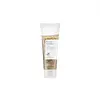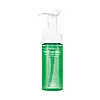What's inside
What's inside
 Key Ingredients
Key Ingredients

 Benefits
Benefits

 Concerns
Concerns

 Ingredients Side-by-side
Ingredients Side-by-side

Water
Skin ConditioningDisodium Cocoamphodiacetate
CleansingGlycerin
HumectantCoco-Betaine
CleansingDisodium Cocoyl Glutamate
CleansingAcrylates Copolymer
Sodium Chloride
Masking1,2-Hexanediol
Skin ConditioningCentella Asiatica Flower/Leaf/Stem Extract
Skin ConditioningCentella Asiatica Extract
CleansingFicus Carica Fruit Extract
HumectantSolanum Melongena Fruit Extract
Skin ConditioningLonicera Japonica Flower Extract
Skin ConditioningForsythia Suspensa Fruit Extract
AntioxidantAngelica Gigas Root Extract
Skin ConditioningCnidium Officinale Root Extract
Skin ConditioningGardenia Jasminoides Fruit Extract
Cosmetic ColorantCoptis Japonica Root Extract
Skin ConditioningGlycyrrhiza Uralensis Root Extract
Skin ConditioningPogostemon Cablin Leaf Oil
MaskingJuniperus Virginiana Oil
MaskingArtemisia Vulgaris Oil
PerfumingHydrogenated Lecithin
EmulsifyingMentha Arvensis Leaf Oil
MaskingCitric Acid
BufferingPolyglyceryl-10 Laurate
Skin ConditioningBeta-Glucan
Skin ConditioningTromethamine
BufferingHexylene Glycol
EmulsifyingSodium Phytate
Panthenol
Skin ConditioningCeramide NP
Skin ConditioningEthylhexylglycerin
Skin ConditioningHydroxyacetophenone
AntioxidantWater, Disodium Cocoamphodiacetate, Glycerin, Coco-Betaine, Disodium Cocoyl Glutamate, Acrylates Copolymer, Sodium Chloride, 1,2-Hexanediol, Centella Asiatica Flower/Leaf/Stem Extract, Centella Asiatica Extract, Ficus Carica Fruit Extract, Solanum Melongena Fruit Extract, Lonicera Japonica Flower Extract, Forsythia Suspensa Fruit Extract, Angelica Gigas Root Extract, Cnidium Officinale Root Extract, Gardenia Jasminoides Fruit Extract, Coptis Japonica Root Extract, Glycyrrhiza Uralensis Root Extract, Pogostemon Cablin Leaf Oil, Juniperus Virginiana Oil, Artemisia Vulgaris Oil, Hydrogenated Lecithin, Mentha Arvensis Leaf Oil, Citric Acid, Polyglyceryl-10 Laurate, Beta-Glucan, Tromethamine, Hexylene Glycol, Sodium Phytate, Panthenol, Ceramide NP, Ethylhexylglycerin, Hydroxyacetophenone
Water
Skin ConditioningCentella Asiatica Extract
CleansingGlycerin
HumectantDisodium Cocoamphodiacetate
CleansingCoco-Betaine
CleansingSodium Chloride
MaskingDisodium Cocoyl Glutamate
Cleansing1,2-Hexanediol
Skin ConditioningPanthenol
Skin ConditioningCentella Asiatica Leaf Extract
Skin ConditioningBeta-Sitosterol
Emulsion StabilisingMadecassoside
AntioxidantPhytosterols
Skin ConditioningBeta-Glucan
Skin ConditioningAsiaticoside
AntioxidantCentella Asiatica Root Extract
Skin ConditioningCeramide NP
Skin ConditioningHyaluronic Acid
HumectantMadecassic Acid
Skin ConditioningNonapeptide-1
Skin ConditioningDipeptide Diaminobutyroyl Benzylamide Diacetate
Skin ConditioningAcetyl Hexapeptide-8
HumectantCopper Tripeptide-1
Skin ConditioningTripeptide-1
Skin ConditioningPalmitoyl Tetrapeptide-7
Skin ConditioningPalmitoyl Tripeptide-1
Skin ConditioningPalmitoyl Tripeptide-5
Skin ConditioningPalmitoyl Pentapeptide-4
Skin ConditioningPalmitoyl Hexapeptide-12
Skin ConditioningPentapeptide-3
Skin ConditioningHexapeptide-9
Skin ConditioningFicus Carica Fruit Extract
HumectantHydrogenated Lecithin
EmulsifyingAsiatic Acid
Skin ConditioningHydrolyzed Sodium Hyaluronate
Skin ConditioningHydrolyzed Hyaluronic Acid
HumectantSodium Hyaluronate Dimethylsilanol
HumectantSodium Hyaluronate
HumectantCitric Acid
BufferingHexylene Glycol
EmulsifyingButylene Glycol
HumectantSaccharomyces Ferment
Skin ConditioningDimethylsilanol Hyaluronate
HumectantSodium Hyaluronate Crosspolymer
HumectantPotassium Hyaluronate
Skin ConditioningHydroxypropyltrimonium Hyaluronate
Sodium Acetylated Hyaluronate
HumectantHydroxyacetophenone
AntioxidantEthylhexylglycerin
Skin ConditioningWater, Centella Asiatica Extract, Glycerin, Disodium Cocoamphodiacetate, Coco-Betaine, Sodium Chloride, Disodium Cocoyl Glutamate, 1,2-Hexanediol, Panthenol, Centella Asiatica Leaf Extract, Beta-Sitosterol, Madecassoside, Phytosterols, Beta-Glucan, Asiaticoside, Centella Asiatica Root Extract, Ceramide NP, Hyaluronic Acid, Madecassic Acid, Nonapeptide-1, Dipeptide Diaminobutyroyl Benzylamide Diacetate, Acetyl Hexapeptide-8, Copper Tripeptide-1, Tripeptide-1, Palmitoyl Tetrapeptide-7, Palmitoyl Tripeptide-1, Palmitoyl Tripeptide-5, Palmitoyl Pentapeptide-4, Palmitoyl Hexapeptide-12, Pentapeptide-3, Hexapeptide-9, Ficus Carica Fruit Extract, Hydrogenated Lecithin, Asiatic Acid, Hydrolyzed Sodium Hyaluronate, Hydrolyzed Hyaluronic Acid, Sodium Hyaluronate Dimethylsilanol, Sodium Hyaluronate, Citric Acid, Hexylene Glycol, Butylene Glycol, Saccharomyces Ferment, Dimethylsilanol Hyaluronate, Sodium Hyaluronate Crosspolymer, Potassium Hyaluronate, Hydroxypropyltrimonium Hyaluronate, Sodium Acetylated Hyaluronate, Hydroxyacetophenone, Ethylhexylglycerin
Ingredients Explained
These ingredients are found in both products.
Ingredients higher up in an ingredient list are typically present in a larger amount.
1,2-Hexanediol is a synthetic liquid and another multi-functional powerhouse.
It is a:
- Humectant, drawing moisture into the skin
- Emollient, helping to soften skin
- Solvent, dispersing and stabilizing formulas
- Preservative booster, enhancing the antimicrobial activity of other preservatives
Beta-Glucan is a polysaccharide. It can be derived from the cell walls of seaweed, oats, yeast, and fungi. It hydrates the skin and helps boost your skin's natural barrier.
As an antioxidant, beta-glucan helps fight free-radicals. Free-radicals are molecules that may damage your skin cells, such as pollution.
Studies show this ingredient may be an effective wrinkle reducer as it can deeply penetrate into skin. It has also been show to help with wound healing.
Learn more about Beta-GlucanCentella Asiatica Extract (Centella) is derived from an herb native to Southeast Asia. It is famous for its anti-inflammatory and soothing properties.
Centella is rich in antioxidants and amino acids, such as Madecassic Acid and Asiaticoside.
Studies show the compounds in centella help with:
The combination of all these properties makes centella effective at soothing, hydrating, and protecting the skin.
Other great components of centella include Vitamin A, vitamin C, several B vitamins, and Asiatic Acid.
Fun fact: Centella has been used as a medicine and in food for many centuries. As a medicine, it is used to treat burns, scratches, and wounds.
Learn more about Centella Asiatica ExtractCeramide NP is a type of ceramide and formally known as ceramide 3.
Ceramides are intercellular lipids naturally found in our skin that bonds dead skin cells together to create a barrier. They are known for their ability to hold water and thus are a great ingredient for dry skin.
Ceramides are an important building block for our skin barrier. A stronger barrier helps the skin look more firm and hydrated. By bolstering the skin ceramides act as a barrier against irritating ingredients. This can help with inflammation as well.
If you would like to eat ceramides, sweet potatoes contain a small amount.
Read more about other common types of ceramides here:
Ceramide AP
Ceramide EOP
Citric Acid is an alpha hydroxy acid (AHA) naturally found in citrus fruits like oranges, lemons, and limes.
Like other AHAs, citric acid can exfoliate skin by breaking down the bonds that hold dead skin cells together. This helps reveal smoother and brighter skin underneath.
However, this exfoliating effect only happens at high concentrations (20%) which can be hard to find in cosmetic products.
Due to this, citric acid is usually included in small amounts as a pH adjuster. This helps keep products slightly more acidic and compatible with skin's natural pH.
In skincare formulas, citric acid can:
While it can provide some skin benefits, research shows lactic acid and glycolic acid are generally more effective and less irritating exfoliants.
Most citric acid used in skincare today is made by fermenting sugars (usually from molasses). This synthetic version is identical to the natural citrus form but easier to stabilize and use in formulations.
Read more about some other popular AHA's here:
Learn more about Citric AcidCoco-Betaine is the natural version of Cocamidopropyl Betaine. It is often derived from coconuts.
Coco-Betaine is a surfactant, meaning it helps remove dirt and oil from the skin.
Disodium Cocoamphodiacetate is a surfactant and helps cleanse skin. It is created from the fatty acids of coconut oil.
Surfactants help rinse oil, dirt, and other pollutants easily from skin. It has a faint fruit-like scent.
We don't have a description for Disodium Cocoyl Glutamate yet.
Ethylhexylglycerin (we can't pronounce this either) is commonly used as a preservative and skin softener. It is derived from glyceryl.
You might see Ethylhexylglycerin often paired with other preservatives such as phenoxyethanol. Ethylhexylglycerin has been found to increase the effectiveness of these other preservatives.
Ficus Carica Fruit Extract comes from the fruit known as the fig. Figs are rich in antioxidants and helps hydrate the skin.
Figs also contain fatty acids and Vitamins A, B1, and B2.
As a humectant, figs are able to draw moisture from the air to your skin. This helps keep your skin hydrated.
Learn more about Ficus Carica Fruit ExtractGlycerin is already naturally found in your skin. It helps moisturize and protect your skin.
A study from 2016 found glycerin to be more effective as a humectant than AHAs and hyaluronic acid.
As a humectant, it helps the skin stay hydrated by pulling moisture to your skin. The low molecular weight of glycerin allows it to pull moisture into the deeper layers of your skin.
Hydrated skin improves your skin barrier; Your skin barrier helps protect against irritants and bacteria.
Glycerin has also been found to have antimicrobial and antiviral properties. Due to these properties, glycerin is often used in wound and burn treatments.
In cosmetics, glycerin is usually derived from plants such as soybean or palm. However, it can also be sourced from animals, such as tallow or animal fat.
This ingredient is organic, colorless, odorless, and non-toxic.
Glycerin is the name for this ingredient in American English. British English uses Glycerol/Glycerine.
Learn more about GlycerinHexylene Glycol is a surfactant. Glycols are a class of alcohols. Hexylene Glycol is a surfactant and emulsifier.
As a surfactant, Hexylene Glycol helps gather dirt and oil on your skin to be washed away.
As an emulsifier, Hexylene Glycol helps keep water and oil together. This prevents them from separating in a product. Hexylene Glycol also thins out the texture of a product by lessening viscosity.
Hexylene Glycol has a small molecular weight.
Learn more about Hexylene GlycolHydrogenated Lecithin is created from the hydrogenation of lecithin (a group of phospholipids). Hydrogenation is a chemical reaction between hydrogen and another element.
This ingredient is an emollient and emulsifier. As an emollient, it helps soften skin by trapping moisture within. As an emulsifier, it prevents oil and water ingredients from separating.
Hydroxyacetophenone is antioxidant with skin conditioning and soothing properties. It also boosts the efficiency of preservatives.
This ingredient is not irritating or sensitizing.
Panthenol is a common ingredient that helps hydrate and soothe the skin. It is found naturally in our skin and hair.
There are two forms of panthenol: D and L.
D-panthenol is also known as dexpanthenol. Most cosmetics use dexpanthenol or a mixture of D and L-panthenol.
Panthenol is famous due to its ability to go deeper into the skin's layers. Using this ingredient has numerous pros (and no cons):
Like hyaluronic acid, panthenol is a humectant. Humectants are able to bind and hold large amounts of water to keep skin hydrated.
This ingredient works well for wound healing. It works by increasing tissue in the wound and helps close open wounds.
Once oxidized, panthenol converts to pantothenic acid. Panthothenic acid is found in all living cells.
This ingredient is also referred to as pro-vitamin B5.
Learn more about PanthenolChances are, you eat sodium chloride every day. Sodium Chloride is also known as table salt.
This ingredient has many purposes in skincare: thickener, emulsifier, and exfoliator.
You'll most likely find this ingredient in cleansers where it is used to create a gel-like texture. As an emulsifier, it also prevents ingredients from separating.
There is much debate on whether this ingredient is comedogenic. The short answer - comedogenic ratings don't tell the whole story. Learn more about comegodenic ratings here.
The concensus about this ingredient causing acne seems to be divided. Research is needed to understand if this ingredient does cause acne.
Scrubs may use salt as the primary exfoliating ingredient.
Learn more about Sodium ChlorideWater. It's the most common cosmetic ingredient of all. You'll usually see it at the top of ingredient lists, meaning that it makes up the largest part of the product.
So why is it so popular? Water most often acts as a solvent - this means that it helps dissolve other ingredients into the formulation.
You'll also recognize water as that liquid we all need to stay alive. If you see this, drink a glass of water. Stay hydrated!
Learn more about Water